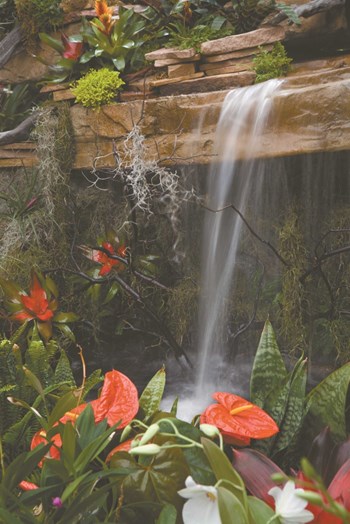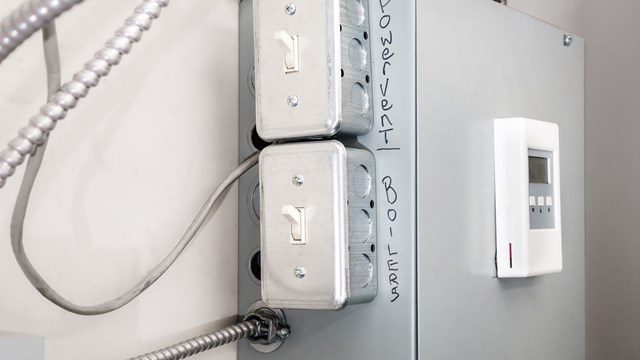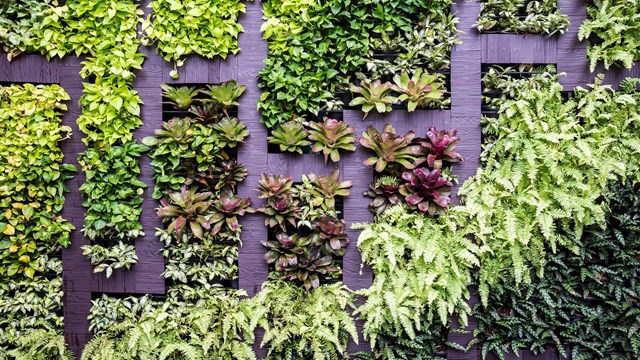
Whether indoors or out, few design elements are as dramatic and arresting as a waterfall, water wall, koi pond, reflecting pool or statuesque fountain. These water features add beauty and value to any property or building, whether they are inside a lobby or common area or outside a gathering area or main entrance.
What’s Available
Water features can be inside or outside and include anything from a simple brick-paved garden pond to an extensive man-made filtered pond complete with fish, waterfalls, flowers and plants. According to PondWorks, an aquatic design, construction and maintenance company that offers services in six states nationally from New York to Maryland, garden ponds are perhaps the most common type of water feature one can have. Both formal and naturalistic, they come in nearly every size, shape and style and are found in both residential and commercial settings.
Garden ponds are water features that usually contain plants and fish and can be lush living habitats for many species. These features accentuate and enhance the environment and are often a focal point of any design. Garden ponds are balanced, healthy aquatic ecosystems. Filtration systems for these water features use both biological and mechanical means but are generally smaller, less complex and less costly than that of a comparable size koi pond, according to PondWorks.
Koi ponds, says PondWorks, are water features designed around fish, and they can be either formal or informal. Pond volume and dimensions are key to achieving the best results. Koi ponds and the filtration systems that support them are designed to manage a given fish capacity and keep them healthy and thriving. Through proper design, filtration collects and neutralizes fish waste and controls outside environmental effects on the pond.
Other less-intensive water features are fountains and indoor water walls, although they require a certain amount of maintenance to keep them functioning properly. Adding a fountain and aerator to an HOA’s pond or lake not only looks pretty but serves an environmental purpose, by improving water circulation and increasing dissolved oxygen levels in waterways. This limits the growth of algae and helps to sustain fish and other aquatic animals.
Steve Mitchell of Natures Elite Landscaping in Meredith, New Hampshire, says water features are certainly a nice amenity that many of his condominium clients seek. While expenses are on the minds of many homeowners these days, he says that a water feature that is more in vogue now is pondless waterfalls. A pondless waterfall is a recirculating waterfall or stream powered by pumps and filters, without the presence of a pond.
“The things that seem to be popular now that were really not on the radar 15 years ago, are pondless waterfalls, especially useful in condominiums or HOAs with smaller children or even grandchildren. The pondless system seems to be the most cost effective and still gives you the same excitement of the waterfall—without having to worry about the algae problems associated with ponds. And also you do not have to deal with the fish or the predators that eat them, herons, raccoons, etc.”
And, Mitchell says, “Another great thing about pondless waterfalls is the fact that they really do not have to run continuously; they can be set up to run only during daylight hours to save on electricity, or if cost is not an object, they can be lit up with low voltage lighting to highlight the waterfall.”
Nice to Have, But…
Water features are a nice amenity to have, say several New England area landscape designers, however, there are a few contributing factors that make them seem prohibitive to condominium and HOA boards and trustees.
Cost, maintenance and upkeep, and colder temperatures found in the region make water features a less popular alternative to more traditional landscaping such as plants, pavers and seasonal ornamentals.
“The people that I’m dealing with have sold their primary residence, and they’re going into condos almost as big as their primary residence, but they don’t have the outdoor maintenance. I’m just not getting a call for it. In New England, that’s just been my experience,” says Maria von Brincken, APLD, a certified landscape designer from Sudbury, Massachusetts. She says that the overall cost and expense in putting in water features, which can run into thousands or tens or thousands of dollars, not including the maintenance, is a major factor.
Even pondless waterfalls, which are nice to look at, and easier to install because of space considerations, create maintenance issues. There are filters, bio-filters, pumps, heating elements, and lighting to maintain, von Brincken says. “There might be a whole new wave of condo owners, and I’d be glad to talk about how lovely they can be. But I just haven’t run into anyone lately that wants to spend the money or wants to spend the time for the maintenance.”
She loves the idea of it, though. “Other than the costs and maintenance, there aren’t any disadvantages, it adds to your life. The sounds of the water, the birds come to it, the frogs. The sunlight sparkling off of it, the reflection of it lighted at night. There’s just so many benefits. It’s more than aesthetic, it’s sensory.
“You look at so many gardens. If it’s done right, you’ve got a beautiful thing to look at. If you’ve got a water feature, you’ve got that additional sensory information and that really just adds in a way,” adds von Brincken.
Another benefit is a noise buffer, she says. “A lot of these condos are built near a highway and it can block out traffic noises if it’s sited properly. You can be sitting on your back patio and not hear the roar of the highway nearby and that’s a huge feature.”
The bottom line, though, she says, is that they do need upkeep, and as long as you hire out somebody that knows what they’re doing, the landscaping or water feature will last and work as intended.
Creative Choices
When you think of a water feature, you probably think of a standard three-tier fountain, a common item on many properties, but today there are more water features than fountains to choose from.
Sean So of Water Studio says that it’s not just about placing any water feature on a property for his Northeast clients; it’s about the space it creates. “We work to create a tranquil space and enhance the space that’s there,” he says. “Also, residents really love the water features.”
HOAs can be creative when choosing and installing a water feature by utilizing unused space. “We worked with one client to create an exciting water feature. The building had old outdoor elevator shafts which weren’t being used, so we installed 40-foot water walls inside the elevator shafts and it aesthetically softened that part of the building,” says So, whose California-based company has designed hundreds of water projects nationwide, including several in New England. “It was quite dramatic.”
A combination fire and water feature—as a bowl, wall, stack of stones or fountain—is also growing in popularity, says So. “They are water fountains during the day and they turn into fire pits at night, where the residents can gather around.”
Site requirements depend on what fountain or water feature is chosen. A water supply, drain and power source for the pump and any underwater lighting are typically required for the water features.
There are a lot of parameters that go into planning installation of a fountain. You have to determine the height, the size nozzle for the spray, and the radius of the spray based on elements like wind and weather, experts say.
Although fun and interesting to look at, koi ponds are not typical water features for condo and HOA buildings, since they require more maintenance and the fish need to be fed. However, they are no longer as maintenance-intensive as they once were.
Designing a water feature that blends with the property should also depend on the building’s architectural style. For example, a traditional, three-tiered fountain of yesteryear would work well with a traditional building, while a black granite reflecting pool would look better on the property of a more contemporary building. It’s easier to install water features in a new building by working with an architect from the ground up.
Keeping It Running
Water features are quite exquisite to look at, but require some maintenance to prevent leaks, algae growth and insects. “It’s similar to having a pool, spa or anything with water,” says So. “It requires regular maintenance. If the association has someone who takes care of their pool, that person should take care of the water feature, too. Today’s systems are designed with filtration and sanitizing systems, chlorinators, sterilizers, ozonizers and more. That doesn’t mean that there aren’t going to be problems, especially leaks.”
Ponds, say von Brincken, need to be taken care of more on a quarterly basis. Namely, you have to clean out the filters, keep them free of leaves and other debris, and put in the right chemicals to keep them running properly.
Also, choosing the right company to install the water feature is vital to preventing leaks and other problems. The building staff should also be instructed to remove, on a daily and as-needed basis, any debris and dead plant matter. They should be trained to check the chemical balance of the water and inspect the feature regularly for leaks. Seasonal maintenance applies most commonly to outdoor water features. These need to be winterized to prevent damage to the structure and to the water pipes during colder months. Some water features also come with a heater that prevents the water from freezing and, ultimately, breaking the equipment.
The board or management should work closely with a qualified landscape architect to choose a water feature and make sure that it makes the right statement and is installed properly. In some cases, the professional might even suggest forgoing the water feature for some other design feature. “We’ll say ‘no’ if they want something that’s too big for the space or it’s going to cause splashing issues,” says So, whose studio works with a variety of materials ranging from corrosion-resistant metals, such as stainless steel and copper, to a wide selection of stone and glass.
The cost of water features depends on the type, materials chosen, the complexity of the job and the customization. The more the projects are customized, the higher the prices. Some water features can start around a few thousand dollars and go up to $250,000, but they definitely make a statement.
“Water fits into any landscape and almost everyone is mesmerized by water, the sounds and look,” says one landscaper. “It’s a nice addition to any property and is a calming, comforting feeling.”
Debra A. Estock is executive editor of New England Condominium. Freelance writer Lisa Iannucci contributed to this article.






Leave a Comment